Hearty Julia Child French Stew Recipe for Cozy Dinners
Julia Child’s French stew ignites a culinary passion that dances across taste buds with wild abandon.
Imagine a dish so deeply comforting it whispers stories of rustic kitchens and generations of simmering love.
Tender meats surrender to slow cooking, melting into a velvet landscape of herbs and robust flavors.
Vegetables transform, creating a harmonious symphony that elevates humble ingredients into an extraordinary meal.
Each spoonful carries the soul of traditional French cooking, rich with depth and nuanced warmth.
Fragrant and nourishing, this stew transcends mere sustenance, becoming a celebration of flavor and connection.
You’ll find yourself craving every luxurious, soul-warming bite of this timeless masterpiece.
Quick Recipe Overview
What You’ll Need for Julia’s French Stew
For Protein:For Aromatic Herbs and Spices:For Liquid Base and Flavor Enhancers:For Thickening Agent:For Vegetable Companions:For Aromatics:For Finishing Touches:Cooking Tools to Braise a French Stew
Step-by-Step for a Rustic French Stew
Heat olive oil in a large Dutch oven. Brown beef in batches until deep golden, creating rich caramelized edges. Transfer meat to a separate plate, leaving behind delicious browned bits.
Sauté onions and garlic in the same pot, releasing their sweet essence. Splash in balsamic vinegar to deglaze, scraping up all the concentrated flavor stuck to the bottom. Stir in tomato paste and let it bloom for a moment.
Return beef to the pot and dust with flour, allowing it to coat and thicken. Pour in red wine and beef broth, adding bay leaf, thyme, and a touch of sugar. Let the mixture come to a gentle bubble, blending all the complex flavors together.
Cover the pot and slide into a 325°F oven. Let the stew braise for two hours, transforming tough meat into meltingly tender bites. The low, slow cooking will marry all the ingredients into a deeply comforting dish.
Add chunky carrots and potatoes to the stew. Return to the oven for another hour, allowing vegetables to soften and the liquid to thicken into a rich, velvety sauce.
Remove bay leaf and taste, adjusting seasonings as needed. Serve piping hot or let the stew rest overnight to develop even more intense flavors. Garnish with fresh parsley for a bright, fresh finish.
Ingredient Swaps and Cooking Tweaks
Serving Stew Like a Bistro Favorite
Stew Storage for Easy Reheating
Print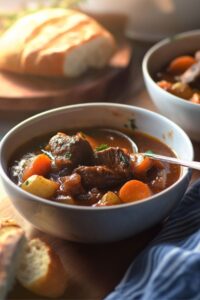
Rustic Julia Child French Stew Recipe
- Total Time: 3 hours 15 minutes
- Yield: 5 1x
Description
Hearty boeuf bourguignon celebrates classic French cuisine with rich beef braised in red wine, bacon, and aromatic herbs. Sophisticated flavors meld together, creating a comforting dish you’ll savor with pure culinary delight.
Ingredients
- 3 lbs (1.36 kg) beef chuck (boneless, cut into 1½-inch pieces)
- 2 cups dry red wine
- 2 cups beef broth
- 2 cups water
- 4 large carrots (peeled, cut into 1-inch chunks on diagonal)
- 1 lb (0.45 kg) small white boiling potatoes (baby yukons, cut in half)
- 2 medium yellow onions (cut into 1-inch chunks)
- 7 cloves garlic (peeled and smashed)
- 3 tbsps olive oil
- ¼ cup all-purpose flour
- 2 tbsps balsamic vinegar
- 1½ tbsps tomato paste
- 2 tsps salt
- 1 tsp freshly ground black pepper
- 1½ tsps sugar
- 1 bay leaf
- ½ tsp dried thyme
- Fresh chopped parsley (optional, for serving)
Instructions
- Preparation: Position oven rack in lower-middle section and heat to 325°F. Pat beef cuts dry and season generously with salt and pepper.
- Searing: Heat olive oil in Dutch oven over medium-high heat. Brown beef in batches, creating a deep golden crust, about 5 minutes per batch. Remove meat and reserve pan drippings.
- Aromatics: In the same pot, sauté onions and garlic, deglazing with balsamic vinegar to capture browned bits. Stir in tomato paste for one minute to develop rich flavor.
- Combining: Return seared beef to pot, dust with flour, ensuring even coating. Add red wine, beef broth, water, bay leaf, thyme, and sugar. Bring to gentle boil while scraping pot bottom.
- Braising: Cover Dutch oven and transfer to preheated oven. Braise for 2 hours to tenderize meat and develop complex flavors.
- Vegetable Integration: Remove pot, fold in carrots and potatoes. Return to oven for additional hour until vegetables are tender and sauce thickens.
- Finishing: Discard bay leaf and adjust seasoning. For optimal flavor, rest overnight in refrigerator before reheating. Serve warm, garnished with fresh parsley.
Notes
- Meat Preparation Tip: Pat beef completely dry before seasoning to ensure perfect caramelization and develop a rich, golden crust during browning.
- Batch Browning Strategy: Never overcrowd the pot when searing meat; cook in separate batches to guarantee each piece develops deep, complex flavors and achieves optimal browning.
- Flavor Layering Technique: Deglaze the pan with balsamic vinegar to capture and incorporate all the delicious browned bits, creating a more intense and nuanced taste profile.
- Overnight Resting Magic: Allow the stew to rest in the refrigerator overnight, which enables flavors to meld and intensify, resulting in a more delicious and harmonious dish.
- Prep Time: 15 minutes
- Cook Time: 3 hours
- Category: Dinner
- Method: Roasting
- Cuisine: American
Nutrition
- Serving Size: 5
- Calories: 550
- Sugar: 4 g
- Sodium: 800 mg
- Fat: 30 g
- Saturated Fat: 8 g
- Unsaturated Fat: 20 g
- Trans Fat: 0 g
- Carbohydrates: 40 g
- Fiber: 5 g
- Protein: 35 g
- Cholesterol: 90 mg

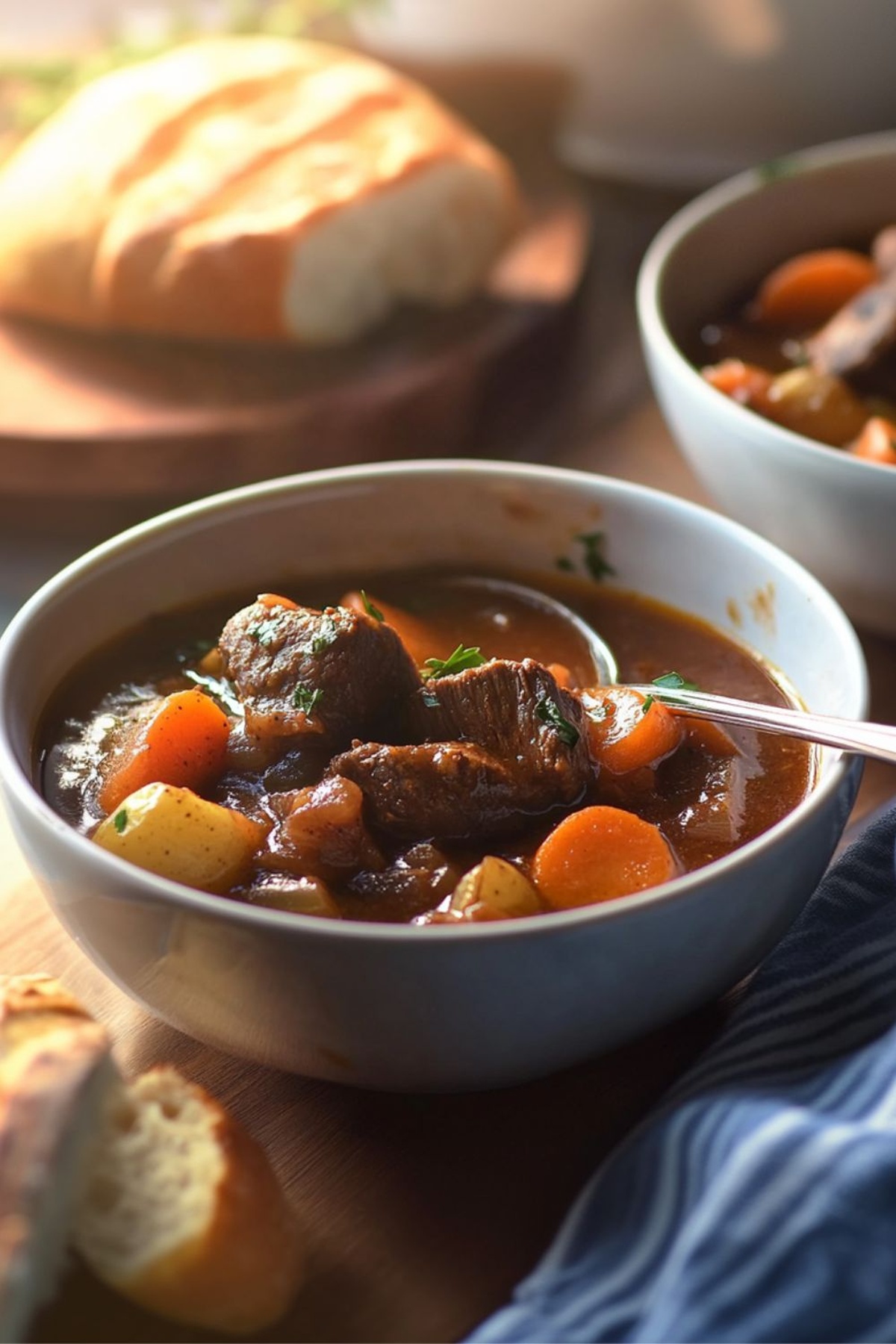
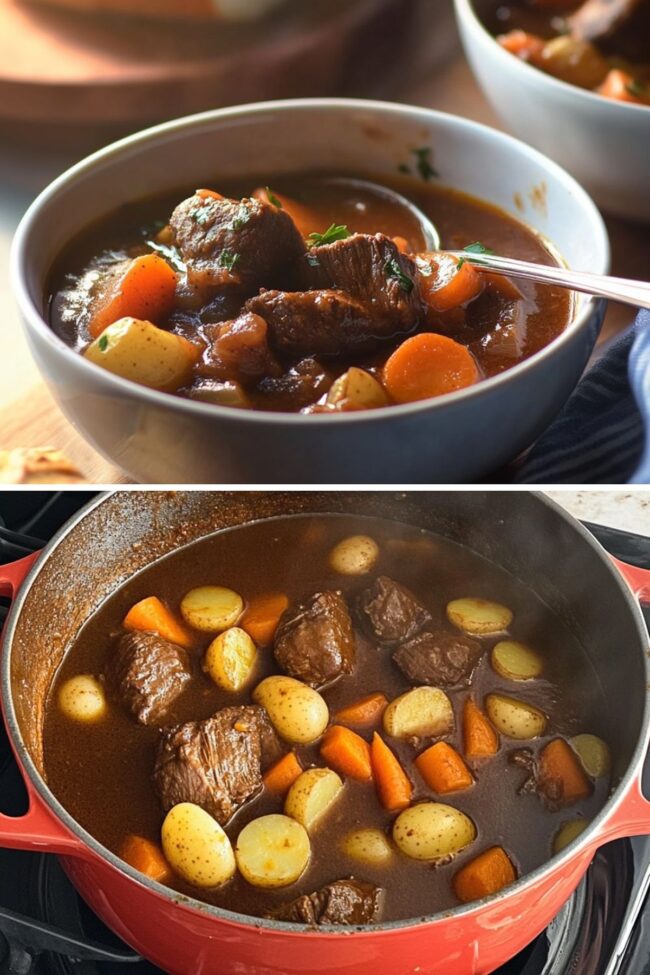
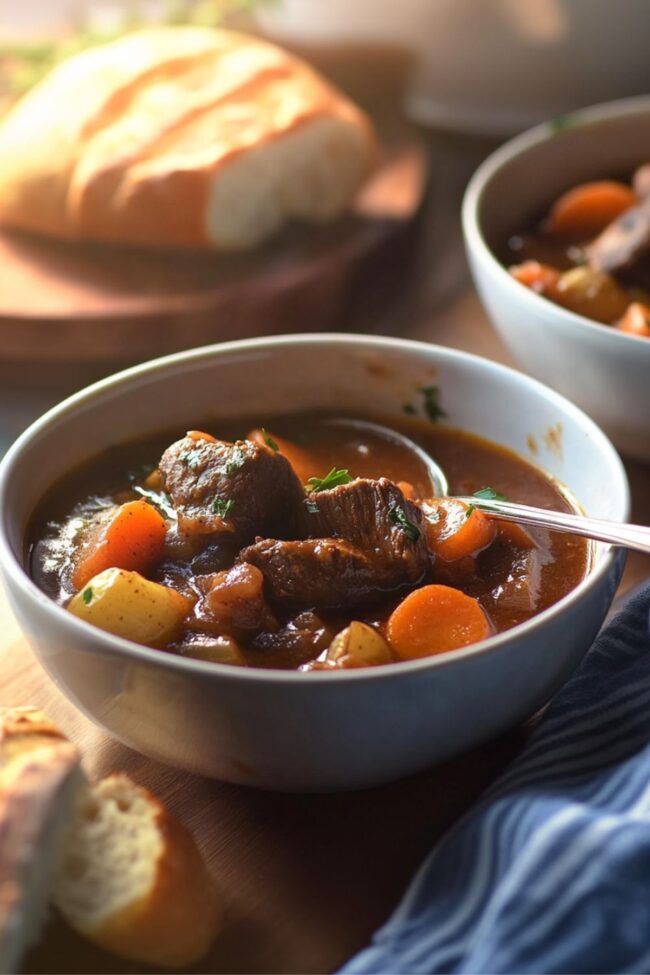

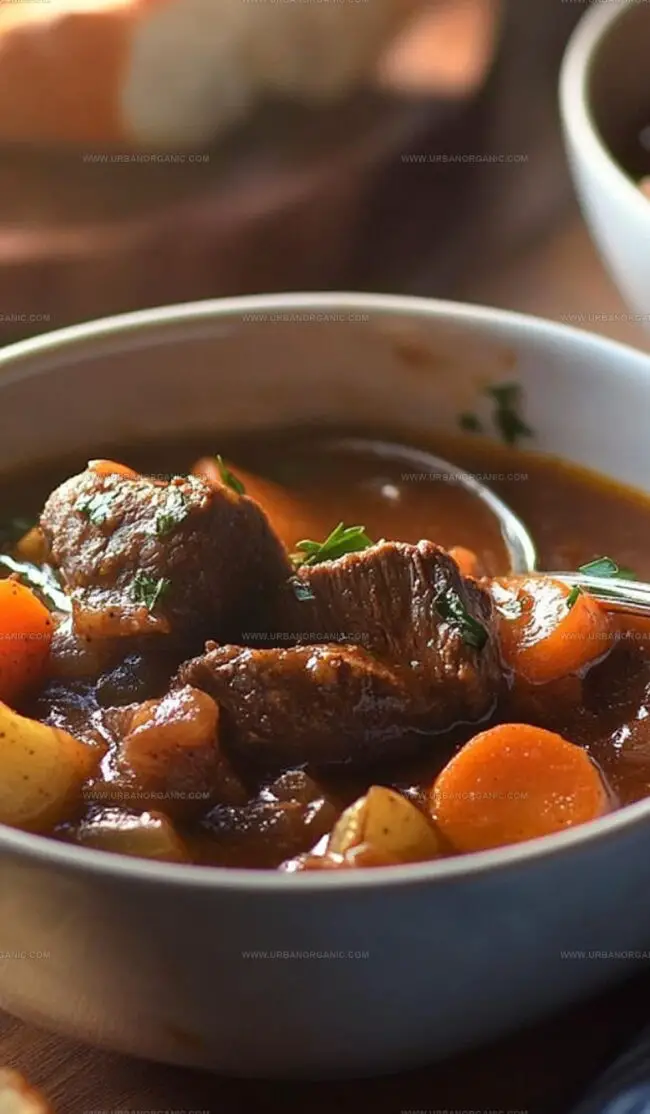
Michael Thompson
Founder & Culinary Director
Expertise
Classical & Contemporary Cooking Techniques, Global Cuisine Appreciation, Nutrition & Menu Engineering, Sustainable Cooking Practices, Farm-to-Table Cuisine
Education
Southwestern Oregon Community College
Michael grew up in Oregon, where he learned early that food tastes better when it’s fresh, local, and made with care.
After earning his degree from the Southwestern Oregon Community College, he focused his career on teaching others how to cook with the seasons, reduce food waste, and reconnect with what’s on their plate.
Michael keeps his cooking simple, sustainable, and full of flavor. His favorite part of the process? Watching people realize how easy and satisfying it can be to cook a single great meal from scratch.